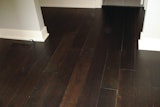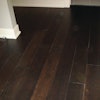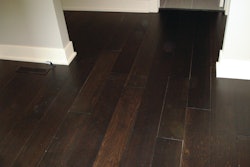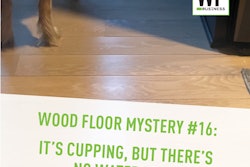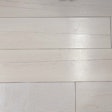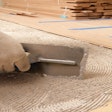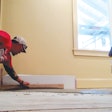I could tell that it was a cold winter without even looking at the thermometer. I had so many phone calls and emails about gaps in floors. The comments ranged from "Our floors are two years old, and we didn't have gaps last winter" to "My house is 50 years old and I have never had gaps like this." I usually get some calls about gaps in the winter, but nothing like this winter.
Wood shrinks as it loses moisture, and it loses moisture when the relative humidity is low. So some gaps usually occur in the winter when the humidity is low. The gaps usually close during humid seasons as the wood expands.
Relative humidity (RH) levels in a house are dictated by the psychrometric properties of air. Psychrometrics deals with the thermodynamic relationships between temperature, RH, absolute humidity, dew point, wet bulb, specific volume and enthalpy of air. A basic fundamental psychrometric relationship is that as air is warmed, it can hold more moisture. And conversely, as air is cooled, it can hold less moisture. RH is the ratio of the amount of moisture in the air at a certain temperature compared to the maximum amount of moisture the air can hold at that temperature. So 100% RH air is saturated, and cannot hold any more moisture, while 50% RH air contains half as much as it can at that temperature.
A general rule of thumb is that if the air is heated 20 degrees F, the RH will drop in half.
Based on these relationships, a general rule of thumb is that if the air is heated 20 degrees F, the RH will drop in half. If air at 30 F and 50% RH is heated to 50 F, the RH of the air will be about 25%. Heat the air to 70 F, and the RH will drop to about 12.5% RH. This is what happens in the winter: cold outside air enters a house and is heated to a comfortable level. In doing so, the RH drops, sometimes to an uncomfortable level. When it is really cold outside, like -10 F, the RH drops to about 3%. Wood exposed to 3% RH will shrink, and gaps will develop between boards.
The typical solution to preventing overly dry air in a house is to add moisture. This can be done with humidifiers, boiling water on the stove, lots of steamy showers, or sometimes hanging clothes in the house to dry. I am not saying that these are good options, but they are ways of adding moisture.
How much moisture you need to add depends on how well ventilated (or leaky) the house is, how big the house is, how much moisture is being produced in the house, how cold it is outside, how warm it is inside, and how humid you want it inside. Ventilation rates are typically measured in air changes per hour (ACH). Modern, building-code compliant houses may have leakage rates near 0.3 ACH, while older houses may be near 10 ACH. Leaky, big houses with few people, plants and pets, on a very cold day with warm indoor temperatures will need more moisture added to achieve a certain RH than a tighter, smaller house with more people, and cooler indoor temperatures.
How much moisture you need to add depends on how well ventilated (or leaky) the house is.
Another factor in gapping floors is the speed at which wood dries. A day or two of very cold temperatures won't have much impact, but a long, sustained cold spell can. Heating Degree Days (HDD) is an indication of how much heating is required over some time period. For example, the average January HDD in my hometown is 802. However, the actual HDD in January 2014 was 968, or an increase of about 20%. More HDD over a month or so can result in enough drying time to cause noticeable shrinking of flooring.
RELATED: How to Prevent Wood Floor Gaps in Winter
One phone call I had was about an older, 2,500-square-foot house. They had gaps this winter, but not in the prior 12 years they have owned the 1960s vintage house. They even have a whole house humidifier, but this winter, they had several days of below zero weather. Using psychrometric information, I was able to determine that this house needed approximately 18 pints of water per hour to maintain 30% RH at an outdoor temperature of 0 F. Their 6-pint per hour humidifier could not provide that much moisture. The house then slowly dried during the cold winter, causing floor boards to shrink and gap.
These homeowners could add more humidification, but then other issues can arise. Too much moisture in a house can cause condensation and mold growth on windows, ceilings and exterior walls, so add moisture carefully. A more effective approach would be to reduce ventilation rates if possible. Even turn the thermostat down some on very cold days. Those steps save on energy bills and helps protect both the floors and the house.











